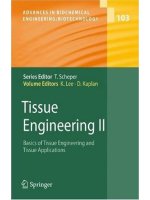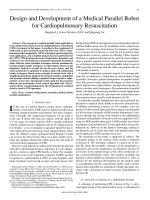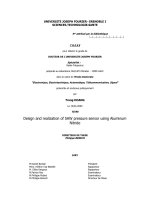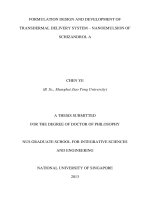Design and development of tissue engineering scafflods using rapid prototyping technology chapter 3
Bạn đang xem bản rút gọn của tài liệu. Xem và tải ngay bản đầy đủ của tài liệu tại đây (399.34 KB, 37 trang )
Chapter Three: Materials and Methods
Chapter Three
Materials and Methods
54
Chapter Three: Materials and Methods
3.1 Polymer Synthesis
All the polymers used in this study were synthesized at the Centre de
Recherche sur les Biopolymères Artificiels (UMR CNRS 5473, Montpellier,
France). ∈-Caprolactone was purchased from Acros Organics. Ethylene
glycol, monohydroxyl PEG (mPEG) and dihydroxyl PEG were supplied by
Fluka and used as received. DL-lactide (DL-LA) was obtained from Purac
(Gorinchem, Holland) and recrystallized from acetone. Zinc powder was
received from Merck. PCL homopolymer, PCL-PEG, PCL-PEG-PCL and
PEG-PCL-PLA block copolymers were synthesized by ring-opening
polymerization (ROP) of ∈-caprolactone using zinc metal as catalyst as
reported elsewhere (Li et al, 1998; Huang et al, 2003).
3.1.1 PCL Homopolymer
PCL homopolymer was synthesized by bulk ROP of ∈-caprolactone, using
ethylene glycol as initiator and zinc powder as catalyst. ∈-Caprolactone and
ethylene glycol with a molar ratio of 700/1 and zinc powder (0.05 wt %) were
introduced into a round-bottomed flask. After degassing at room temperature,
the flask was sealed under vacuum and allowed to rotate at 140
°
C for 11
days.
3.1.2 PCL/PEG Block Copolymers
Predetermined amounts of ∈-caprolactone, mPEG or dihydroxyl PEG and
zinc powder were introduced into a round-bottomed flask. The
caprolactone/ethylene oxide or [CL] / [EO] molar ratio was 3/1. Degassing
55
Chapter Three: Materials and Methods
was performed at 80
°
C to homogenize the mixture. After cooling, the flask
was sealed under vacuum and allowed to rotate at 140
°
C for 7 days.
3.1.3 PEG/PCL/PLA Block Copolymers
The PEG-PCL-P(DL)LA triblock copolymer was synthesized by stepwise ROP
of ε-caprolactone and DL-lactide. In the first step, ε-caprolactone (171 g),
mPEG5000 (22 g) and zinc powder (0.05 wt-%) were introduced into a round-
bottomed flask. Polymerization was carried out under vacuum at 140°C for 9
days. The resulting hydroxyl-bearing PEG-PCL was used as macroinitiator in
the second step for the ROP of DL-lactide. DL-lactide (50 g) was allowed to
polymerize in the presence of this PEG-PCL (50 g) and zinc powder (0.05 wt-
%) under vacuum at 140°C for 8 days.
3.1.4 Purification of Polymers
All the polymers were recovered by the dissolution/precipitation method with
dichloromethane as solvent and ethanol as nonsolvent, followed by filtration
and vacuum drying up to constant weight. PEG-PCL-PLA block copolymer
was further washed with cold acetone (<10°C).
The resulting copolymers were characterized by
1
H nuclear magnetic
resonance (
1
H NMR), size exclusion chromatography (SEC), infrared
spectroscopy (IR), differential scanning calorimetry (DSC), X-ray diffraction,
and thermo gravimetric analysis (TGA).
56
Chapter Three: Materials and Methods
3.1.5 Measurements
1
H NMR spectra were recorded with a Bruker spectrometer operating at
250MHz, using deuterated chloroform as solvent at room temperature. SEC
was performed by using a setting composed of a Waters 510 HPLC pump, a
Waters 410 differential refractometer and a PL gel 5µm mixed-C 60 cm
column, the mobile phase being THF and the flow rate 1 cm3/min. Data were
expressed with respect to polystyrene standards from Polysciences. IR
spectra were recorded with a Perkin Elmer 1760 FTIR spectrometer, the film
being cast on a NaCl plate from THF solutions. DSC measurements were
carried out under nitrogen atmosphere from 20°C to 105°C at 5°C/min on a
Perkin Elmer Instrument DSC6 thermal analyzer. TGA was run on a Perkin
Elmer Instrument TGA6 thermal analyzer from 30°C to 450°C at a heating
rate of 10°C/min. X-ray diffraction spectra were obtained with a Philips
apparatus using a Cu Kα source (λ = 0.154 nm).
3.2 Thermal Analyses of Polymers
3.2.1 Differential Scanning Calorimetry (DSC)
Understanding of the melting behavior of the polymer is important to set an
appropriate liquefier temperature for scaffold fabrication. The thermal
characteristics of the polymers before and after processing into scaffolds were
determined by differential scanning calorimeter (TA Instruments DSC 2910,
New Castle, DE). An indium standard was used to calibrate the instrument.
The sample weight of around 10 mg was taken. All samples were placed in
aluminum pans and scanned from 25
°C
to 95
°C
at a rate of 5
°C
/min, using
argon as purge gas. Five samples for each type of material were analyzed.
57
Chapter Three: Materials and Methods
DSC analysis provided the melting point and degree of crystallinity of the
material. The degree of crystallinity was calculated according to the following
equation:
X
c
= (H
m
/H
m
0
) x 100% (3.1)
where, H
m
is the melting enthalpy of PCL component (only PCL crystallizes in
the copolymers) and H
m
0
is the melting enthalpy of 100% crystalline PCL
(139.5 J/g) (Pitt et al, 1981).
3.2.2 Gel Permeation Chromatography (GPC)
Gel permeation chromatography equipped with a differential refractor (Waters,
Model 410, Milford, MA) and an absorbance detector refractor (Waters, Model
2690, Milford, MA) were used to determine the polymer molecular weight
distribution. The samples were dissolved in tetrahydrofuran (THF) and eluted
in a series of configurations through a Styragel column refractor (Waters,
Milford, MA) at a flow rate of 1mL/min. Polystyrene standards (Polysciences,
Warrington, PA) were used to obtain a calibration curve. The GPC
experiments were carried out over the polymers before and after fabrication of
the scaffold.
3.3 Surface Wetability Determination
The surface wetability or hydrophilicity is a specific physical property of any
given system that is determined by the contact angle. The contact angle is the
angle at which a liquid interface meets the solid surface. Most often the
concept is illustrated with a small liquid droplet resting on a flat horizontal solid
58
Chapter Three: Materials and Methods
surface. The angle between the baseline of the drop and the tangent at the
drop boundary is measured as the contact angle as presented in Figure 3.1.
4.1: Water Contact Angle Measurement on Surface
Water Droplet
Solid Surface
θ
Figure 3.1: Water contact angle measurement on surface
The water contact angle of different polymers (PCL, PCL-PEG, PCL-PEG-
PCL and PEG-PCL-PLA) was measured on their respective solid flat surfaces
by using surface contact angle measuring instrument (VCA Optima XE).
Deionized water drop of 5µL was dispensed onto the polymer surface to
measure the contact angle. Five measurements at five different locations
were performed on each polymer sample and the mean values were taken as
their respective water contact angles.
3.4 Scaffold Processing
3.4.1 Desktop Robot-based RP (DRBRP) Technique
A desktop robot-based rapid prototyping (DRBRP) technique was built in
house that consists of a PC-controlled desktop robot (Sony Robot) and a
pressure driven dispensing system. The robot provides four-axes (Figure 3.2)
movement comprising of three simultaneous translational movements along
the X-, Y- and Z-axes with an additional rotary motion about the Z-axis. The
three translational movements had positioning accuracy of up to 0.05mm and
a minimum step resolution of 0.014mm. The dispensing system involves a
59
Chapter Three: Materials and Methods
cylindrical stainless steel chamber with a replaceable extrusion nozzle,
melting of scaffold material and extrusion of the melt. The stainless steel
chamber is insulated by a teflon shell to prevent heat loss because of the
developed temperature gradient between heated chamber and the
surrounding. The heating system comprises of a thermostat-controlled
electrical band heater attached to the chamber and a thermocouple (type-K)
with an exposed junction inserted near the exit of the chamber, which is used
for temperature feedback. The extrusion system includes purified compressed
air tank and a solenoid valve along with plastic tubing. The incoming
pressurized air extrudes the semi-molten material through the nozzle that is
deposited onto a plastic platform below.
The heater had the temperature
accuracy of up to 2°C and the feed rate had the deposition speed accuracy of
up to 3mm/min.
Material Loading
Port
Teflon
Insulator
Figure 3.2: Four-axes desktop robot-based rapid prototyping system
3.4.2 Basic Scaffold Modeling Process
The modeling process begins with the creation of a solid shape (e. g. simple
cube) in .stl format by CAD software that is imported into slicing software,
60
Chapter Three: Materials and Methods
RPBOD (in house built). The model is then mathematically cut or sliced into
thin horizontal layers in the .cli format, followed by the generation of
deposition paths according to user-defined parameters within each sliced
layer. The deposition path data is subsequently downloaded to the robotic
machine to build the model using a given material. Figure 3.3 schematically
summarizes the basic process of preparing the data of a CAD model in
RPBOD to fabricate the physical part (scaffold) at the DRBRP machine.
3D CAD model in
.stl format
Ste
p
1
Sliced model in
.cli format
Ste
p
2
Sliced model in
.cli format with
deposition path
Ste
p
3
Building of
physical model
Ste
p
4
Z
Y
X
Figure 3.3: Outline of the basic DRBRP process. Step 1: Import of CAD data
in .stl (STereoLithography) format into Sony Robot. Step 2: Slicing of the CAD
model into horizontal layers and conversion into .cli format. Step 3: Creation
of desired deposition paths for each layer to upload to the DRBRP machine.
Step 4: Building of physical model in an additive manner; line-by-line to form a
2D layer and layer-by-layer to form the 3D model
61
Chapter Three: Materials and Methods
3.4.3 Scaffold Design
Various scaffold architectures can be imprinted by applying various lay-down
patterns (0/90°, 0/60/120° and 0/30/60/90/120/150°) as shown in Figure 3.4
using appropriate positioning of the robotic control system. The lay-down
patterns of 0/90°, 0/60/120° and 0/30/60/90/120/150° are also called 2-angle,
3-angle and 6-angle patterns, respectively.
90
o
90
o
120
o
60
o
120
o
60
o
150
o
30
o
0
o
0
o
0
o
A B
D
Figure 3.4: Various lay-down patterns of scaffolds
A): 0/90
o
, (B): 0/60/120
o
, (C): 0/30/60/90/120/150
o
The raw material (polymer) in any form (e.g. powder, pellet, lump etc.) is
loaded into the metallic chamber from the top, melted by electrical heating
and directly extruded out by means of compressed air pressure through the
nozzle. The process of deposition in each layer starts with formation of a
“road” of molten material called, filament with user-defined width and
thickness as presented in Figure 3.5. The structural design features that are
controllable through slicing flow settings include the road width RW, slice
thickness ST, filament gap FG, filament distance and layer gap LG. RW is
defined as the diameter of the circular cross-section of laid filament, ST is the
62
Chapter Three: Materials and Methods
vertical distance between the filament centres of adjacent layers, FG is the
edge-to-edge horizontal distance between adjacent filaments, FD is the
centre-to-centre horizontal distance between adjacent filaments and LG is
defined as the edge-to-edge vertical distance between layers of the same
filament alignment.
Each layer can be filled by rasters, contours or the combination of both. The
raster fill involves a raster motion of the nozzle within a specified region of a
sliced layer. There are three ways of raster motions as shown in Figure 3.6;
first, one way motion where the polymer-melt is dispended only from one
direction of the dispenser movement second, two ways motion where the
polymer-melt is dispensed from two opposite directions but still the dispensing
is not connected and third, round-connected way where the polymer is
dispensed as connected network from both directions.
LG
ΦRW
ST
B A
Figure 3.5: Models of lay-down patterns viewed in cross-section. A:
0/90°, B: 0/60/120°; Symbols are RW: road width, FG: fill gap,
LG: layer gap, ST: slice thickness
FG
FG
FD
LG
63
Chapter Three: Materials and Methods
(A) (B) (C)
Figure 3.6: Different raster motions; (A): one way, (B): two ways, (C): round-
connected way
There are some inherent pros and cons associated with specific raster
motion. For example, in one way motion, the fabrication yield is minimum i.e.
there needs maximum time to build a scaffold with given specifications.
Because, after fabricating one filament the dispenser remains idle while it is
returning back to its starting point for fabricating next filament. The edges
would also be corrugated and thus poor finishing. Besides, an additional thin
filament (Figure 3.7) may be formed diagonally in between two filaments
during the way back of the dispenser, as the polymer being viscous in nature
will continue to drift because of cohesion.
Figure 3.7: One way waster with an additional thin filament
The main advantage of one-way raster motion is that the scaffold edges will
be fully open i.e. there will be no blockage of the channels. It is an especial
64
Chapter Three: Materials and Methods
advantage when there needs to build a scaffold with exact dimensions e.g. of
defect size, without compromising channel connectivity. In the two ways
motion, the fabrication yield is increased but still there is possibility of
producing corrugated edges i.e. poor edge finishing. On the contrary, the
round-connected motion produces high yield along with good edge finishing.
However, there need to compromise channel connectivity at the edges unless
post trimming is carried out. Again, the post trimming involves decrease in
dimension and material wastage.
The contour fill involves several closed loop contour motions of the nozzle
inside a specified region or along the periphery of a cross-sectional layer. The
combination of these two approaches would deposit the molten material within
the specified layer by both contour and raster filling as shown in Figure 3.8.
The contour fill is necessary for good edge finish and providing adhesion to
the raster roads at their ‘U-turns’.
Raster
Contour
Figure 3.8: Combination of raster and contour motion
The DRBRP system is also able to pause and continue the material flow
during the fabrication of process.
65
Chapter Three: Materials and Methods
The scaffold is built in an additive manner; line-by-line to form a 2D layer and
layer-by-layer to form the 3D structure as demonstrated by Figure 3.9. Once a
layer is completed the dispenser moves up vertically in the Z-direction by a
small displacement equivalent to the specified slice thickness (ST).
Pressurized Air
Figure 3.9: Schematic diagram of DRBRP extrusion and deposition process
.4.4 Scaffold Fabrication
escribed in the preceding section. In short, the thermoplastic polymers were
r by electrical heating and extruded out
by means of compressed air pressure through a minute nozzle to build 3D
scaffolds layer by layer. Throughout the study, all the scaffolds were
fabricated by employing round-connected raster motion and no additional
0 Layer 0-90 Layers Multiple Layers
3
The procedure of scaffold fabrication using DRBRP system has already been
d
melted in the stainless steel chambe
66
Chapter Three: Materials and Methods
contour was drawn other than the U-tern formed due to the round-connected
motion. Likewise, the scaffolds were fabricated with nozzle size of 500µm
internal diameter and FD of 1.5mm unless mentioned otherwise.
3.4.4.1 Optimization of Fabrication Process
There are numerous parameters that control the DRBRP system, similar to
DM process as described by Comb et al. (1994a), and Agrawal et al. (1996).
gories, as mentioned
specific
terial specific Geometry
specific
F
These parameters can be broadly divided into four cate
in Table 3.1. They are operation specific, machine specific, material specific
and geometry specific parameters. Most of the parameters are interdependent
and have influence on the scaffolds’ morphological and biomechanical
properties. Therefore, these parameters need to be studied and optimized to
produce scaffolds as required. The scaffold fabrication was focused on using
two polymers namely, PCL and PCL-PEG.
Table 3.1: Various Process Parameters in DRBRP Technique
Operation Machine specific Ma
Slice thickness Nozzle tip size Viscosity Fill vector length
Deposition
speed
Extrusion
pressure
Mechanical
Fill pattern
temperature
Thermal
Flexibility Filament
distance
Road width Filament
diameter
Liquefier
property
conductivity
67
Chapter Three: Materials and Methods
In reality all the parameters listed in Table d
optim ecise co e fabricati s. However, within the
scope of this study three major parameters namely, liquefier temperature (T
L
),
3.1 deserve to be studied an
ized for pr ntrol of th on proces
extrusion pressure (P
E
) and deposition speed (S
D
) were investigated. This
was primarily to investigate the influence of these parameters on the
scaffolds’ morphological and mechanical properties and ultimately to select
the best combination of these parameters to develop scaffolds with structural
reproducibility and integrity. The best selection of process parameters to
fabricate 3D scaffold by a solid freeform fabrication technique involves
complex interactions among hardware, software and material properties
(Comb et al, 1994a). The variation of process parameters produces a range of
road widths for a given nozzle diameter. In this study, to determine the best-
suited values of the process parameters for a given nozzle diameter (e.g. 500
µm), it was targeted to achieve raster RW equivalent to nozzle diameter (i.e.
500 µm) with minimum fabrication time while structural integrity and
reproducibility of the scaffold were maintained. This investigation was carried
out for two polymers (PCL and PCL-PEG) and one lay-down pattern (0/90).
The scaffolds were fabricated employing three values of each parameter for
example, liquefier temperature (80, 90 & 100°
C
), extrusion pressure (3.0, 4.0
& 5.0 bars) and deposition speed (240, 300 & 360 mm/min). Through a series
of trials during which small specimens were fabricated, one parameter was
varied iteratively while other two were kept fixed. Through this investigation
the optimized process parameters were found to be as follows: liquefier
temperature of 90°C, extrusion pressure of 4.0 bars and deposition speed of
68
Chapter Three: Materials and Methods
300 mm/min (see result section 5.5.2 for details). These parameters were set
for all further fabrications.
Upon optimizing the process parameters, the feasibility of another two
ynthetic biopolymers (PCL-PEG-PCL and PEG-PCL-PLA) was investigated
comb like 3D
caffolds, the bulk porosity should be above 30% to avoid creation of isolated
s
to process into 3D porous structure with fully interconnected channels. This
experiment was also to investigate the efficacy of DRBRP system to develop
3D porous scaffolds with a range of polymers, instead of a single one. Again,
the scaffolds were fabricated with a single lay-down pattern (0/90) employing
round-connected raster motion and no additional contour was drawn other
than the U-tern formed due to the round-connected motion. As all four
polymers (PCL, PCL-PEG, PCL-PEG-PCL and PEG-PCL-PLA) have very
close melting temperatures (~65°C) for convenience it was decided to apply
the same process conditions for them. The liquefier temperature, extrusion
pressure and deposition speed were set at 90°C, 4.0 bars and 300 mm/min,
respectively while the ambient temperature was maintained at 25 ± 2°C.
Through this investigation the DRBRP system was found to offer the flexibility
to develop 3D porous scaffolds with various synthetic polymers.
To achieve completely interconnected pore channels in honey
s
voids (Gibson and Ashby, 1997). Based on this phenomenon, various
scaffolds with different values of FD were built up. The scaffolds were
fabricated with two polymers (PCL and PCL-PEG) and a series of FDs (1.0,
1.25 & 1.5 mm) applying the liquefier temperature, extrusion pressure and
69
Chapter Three: Materials and Methods
deposition speed of 90°C, 4.0 bars and 300 mm/min, respectively. This set of
scaffolds was fabricated to investigate the influence of structural design
feature, FD on the scaffolds’ morphological and mechanical properties.
Lastly, to investigate the variation of morphological characteristics,
echanical properties, degradation kinetics and cell culture performances the m
scaffolds were fabricated with three lay-down patterns (0/90°, 0/60/120° and
0/30/60/90/120/150°) using two polymers (PCL and PCL-PEG). The process
conditions i.e. liquefier temperature, extrusion pressure and deposition speed
were set at 90°C, 4.0 bars and 300 mm/min, respectively. The microfilaments
were laid in coordinate degrees according to the respective lay-down patterns
as generate by the machine toolpath. For example, in 0/90° lay-down pattern
the filaments were laid as 0° lines and 90° lines. Likewise, in 0/60/120° lay-
down pattern the filaments were laid as 0° lines, 60° and 120° lines, and in
0/30/60/90/120/150° lay-down pattern the filaments were drawn as 0° lines,
30° lines, 60° lines, 90° lines, 120° lines and 150° lines. Overview of the
toolpath of the scaffold design process is presented in Figure 3.10 in order.
70
Chapter Three: Materials and Methods
Solid model 0°-line 90°-line
Solid model 0°-line 60°-line 120°-line
Model 0°-line 30°-line 60°-line 90°-line 120°-line 150°-line
Figure 3.10: Overview of scaffold design toolpath; top: 2-angle pattern,
middle: 3-angle pattern and bottom: 6-angle pattern
3.4.4.2 Preparation of Test Specimens
The large porous blocks of 50.0 x 50.0 x 5.0 mm were built as initial bulk
scaffolds on a flat plastic platform. After completion of fabrication the bulk
scaffolds were removed from the plastic platform. The corrugated edges
(Figure 3.11) of the scaffold blocks formed due to the “U-turn” of the round-
connected motion of fabrication process were trimmed off to ensure that the
entire specimen had uniform edges (Figure 3.11). Then the trimmed scaffolds
71
Chapter Three: Materials and Methods
were cut into smaller blocks (Figure 3.12) of 6.0 x 6.0 x 5.0 mm with an ultra
sharp blade for further analyses.
Ragged Edge
(A)
Uniform Edge
(B)
Figure 3.11: Photograph of bulk scaffold block; (A): Corrugated edge before
trimming off, (B): Uniform edge after trimming off
72
Chapter Three: Materials and Methods
Step 1
Step 2
Step 3
ILV ILH
OL
Figure 3.12: Cutting of scaffold blocks for various analyses. Three groups of
specimens were labeled namely ILH, ILV and OL representing different
alignment of the filaments with respect to the longitudinal axis of each final
specimen.
3.5 Scaffold Characterization
The scaffolds fabricated with various parameters were characterized in terms
of morphological (porosity, pore size and interconnectivity) and mechanical
(stiffness and yield strength) properties as described bellow:
3.5.1 Scanning Electron Microscopy (SEM)
The scaffold morphology was studied by scanning electron microscope (SEM)
JSM-5800LV (JEOL USA, Peabody, MA) both from top and x-sectional views
to evaluate the micro-structural integrity of as fabricated scaffolds. Scaffold
73
Chapter Three: Materials and Methods
samples were affixed to a stub with carbon paint and coated with gold using a
JEOL fine sputter coater (JFC-1200) for 60 seconds at 10mA. Then the
morphology was observed by SEM operated under high vacuum at an
accelerating voltage of 15kV and a current of 60-90 mA. The SEM images
were used to measure the road width (RW), filament gap (FG), layer gap (LG)
and pore size besides studying the channel interconnectivity. LG and pore
height in z-direction were measured from the X-sectional view, which showed
the stacked layers whereas, RW and pore width in x- or y-direction were
measured from the plan view. All dimensions were measured with respect to
the scale bar on each SEM micrograph using a ruler. The average and
standard deviation from 5 measurements were reported for each sample
group.
3.5.2 Porosity Measurement
To build a porous structure using the DRBRP method the voids were
intentionally introduced to create a network of fully interconnected pores or
channels. The continuous channels of free spaces were introduced within the
CAD model during generation of deposition paths in the sliced layers, which
were imprinted in physical scaffold. The porosity of various scaffolds was
measured by two methods such as ultrapycnometer method and micro-CT
method. The porosity using ultrapycnometer was determined as
P = [(V
a
-V
t
) / V
a
] X 100% (3.2)
74
Chapter Three: Materials and Methods
where, V
a
(mm
3
) is the apparent volume of each scaffold block calculated
from geometry, and V
t
(mm
3
) is the true volume of scaffold specimen
measured by a gas pycnometer (Quantachrome Ultrapycnometer 1000,
Quantachrome Corporation, Boynton Beach, FL) at 25°C in pure argon. The
working principle of the pycnometer is described in Appendix A.
3.5.3 Micro-CT 3D Imaging
The internal 3D architecture and micro-structural formability of as fabricated
scaffolds were studied by Micro-CT. The micro-CT was set at 19 micron
resolution. 2D analyses and 3D reconstructions of core regions of the
samples were performed which enabled to calculate the porosity and
interconnectivity of the scaffolds.
3.5.3.1 Micro-CT Imaging Acquisition
The internal architecture of the scaffold was scanned by using Sky Scan 1072
micro-CT desktop scanner (Skyscan, Belgium). Initially, length measurements
were taken along the sample to determine the degree to which the sample
conformed to the cubical template. The output format for each sample was
approximately 500 serial 1024x1024 bitmap images. Sky Scan’s Tview
software was used to analyze these slice images. The resulting grey-scale
images were segmented and a threshold applied to extract the polymer
architecture and then inverted to extract the pore volume architecture. This
allowed 3D reconstruction of the total object volume (OV), scaffold volume
(SV) and pore volume (PV) (OV=SV+PV) from stacked 2D images, which in
turn could be analyzed to give information on porosity, surface area and pore
75
Chapter Three: Materials and Methods
size using algorithms developed for analyzing bone architecture (Laib et al,
2000). Using a surface meshing technique (Lorensen and Cline, 1987),
specific scaffold surface area was calculated (total surface area/SV). The pore
size distribution was obtained by direct 3D measurement using a distance
transformation technique (Hildebrand and Rüegsegger, 1997), whereby the
number of voxels within the total PV that could be filled by a sphere of a given
diameter Dpore was measured. The average pore diameter was obtained by
taking the mean of over all sphere diameters.
3.5.3.2 3D Reconstruction
Mimics (Materialise, Belgium) along with ImageJ (software) was used for 3D
reconstruction. 62 sequential 200 x 200 pixel images were cropped from the
serial images from the center of each sample. Imported into Mimics, these
serial core images were reconstructed into 3D volumetric models. Thresholds
of – 872 to – 185 HU were inverted to allow measurement of the volume of all
pore spaces within the model. Subsequently, a region-growing operation was
performed, creating a mask consisting only of interconnected pore spaces.
Volume for this region-grown mask was determined and the ratio of region-
grown volume to the total volume was calculated. The percentage of this ratio
is defined as the degree of interconnectivity. The scaffold accessibility (i.e.
pore interconnectivity) was characterized by an algorithm similar to mercury
intrusion porosimetry (Abell, 1999). In other words, by starting at the periphery
of the scaffold and working inwards, at a given sphere diameter, D
int
, the
amount of accessible pore volume was measured. Using a distance
transformation (Hildebrand and Rüegsegger, 1997), the local diameter, D, at
76
Chapter Three: Materials and Methods
every point within the PV was determined. Following a thresholding operation,
the volume of the pores with a local sphere diameter smaller than Dint was
suppressed. All components of this thresholded structure not connected to the
‘outside air’ were then discarded using a component labeling operation.
3.6 Mechanical Characterization
Compression tests were carried out to evaluate compression behavior of
scaffolds and further to investigate the influence of different variables (process
parameters, FD and cross head speed) on their mechanical properties. For
each structural configuration, five samples (6.0 X 6.0 X 5.0 mm) were tested.
They were tested using a uniaxial testing system (Instron 4502) and a 1 kN
load-cell (Canton, MA, USA) adopting the guidelines for compression testing
of acrylic bone cement set in ASTM F451-99a. This is the latest edition of the
standard currently used by a number of research groups (Zein et al, 2002;
Peter et al, 1998; Thomson et al, 1998) to characterize the mechanical
properties of bioresorbable scaffolds of similar geometry. In general, the
specimens were compressed in the Z-direction (i.e. from OL) of fabrication
process at a crosshead speed of 1 mm/min between two steel platens up to a
strain level of approximately 60%. However, to investigate the structural
anisotropy the scaffolds were also compressed in X- and Y-directions of
fabrication process, which accorded to the filament alignments in three
orientations out of layer (OL), in layer horizontal (ILH) and in layer vertical
(ILV) as illustrated in Figure 3.13.
77
Chapter Three: Materials and Methods
OL ILH ILV
OL ILH ILV
Figure 3.13: Alignment of filaments in scaffold specimens; top row: 0/90 lay-
down pattern and bottom row: 0/60 lay-down pattern. In the OL, ILH and ILV
orientations the filaments are aligned along the XY, YZ and XZ planes,
respectively.
In OL loading, layers of deposited filaments were compressed together for all
lay-down patterns. For 0/90° lay-down pattern in both ILH and ILV loading,
one layer out of every 2 layers of filaments was aligned in the direction of
loading. For 0/60/120° lay-down pattern in ILH loading, one layer out of every
3 layers of filaments was aligned normal to the direction of loading. In ILV
loading, one layer out of every 3 layers of filaments was aligned in the
direction of loading. For 0/30/60/90/120/150° lay-down pattern in both ILH and
78









